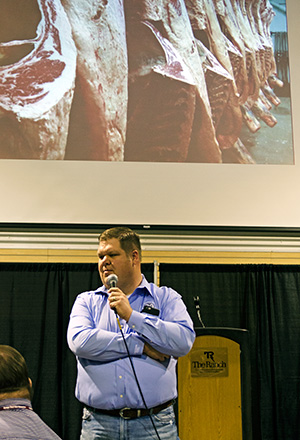Evaluating and Valuing Cull Beef Cows and Their Carcasses
LOVELAND, Colo. (Nov. 19, 2015) — If you think cull cows going to slaughter end up as hamburger, think again. That was the message shared by Colorado State University meat scientist Dale Woerner during the 24th semi-annual Range Beef Cow Symposium Nov. 17-19 in Loveland, Colo. Woerner said cow-calf producers might want to think of animals culled from their breeding herds as more than byproducts of their operations and give some thought to how those animals are marketed.

Colorado State University meat scientist Dale Woerner
“Twenty percent of all beef animals slaughtered are market cows and bulls — a total of 6 to 6.5 million head,” stated Woerner. “These market cows and bulls represent 15% to 20% of a ranch’s income.”
Woerner explained that just a little more than half of all cow beef goes through a grinder. Of the slaughter plants currently harvesting market cows, all are collecting whole-muscle cuts, which provide steaks and roast for foodservice, as well as jerky and other processed meat products.
Woerner said market cow values have undergone drastic changes, noting a doubling of value during the period of widespread drought. During the last 10 years, low to high dressed cow carcass values differed by $130 per hundredweight (cwt.).
Reminding producers of the seasonality of cull-cow markets, Woerner said prices are typically highest from late May to early July and lowest in the fall, when a majority of producers send culls to town. But prices often move higher again during the third week of November and again from late December through the first week of January.
“That’s when sale barns close for the Holidays and there is a decrease in cattle marketings, including cull cows,” Woerner explained.
Along with considering seasonal price advantages, Woerner advised producers to market cows while their condition still represents the greatest value. He said sound cows with body condition scores of 4, 5 and 6 typically reflect the most value. Cows in poorer body condition offer little potential for harvest of whole-muscle cuts and animals that are overly fleshy are discounted for excessive fat and lower red meat yield.
Woerner noted how gourmet or premium burger restaurants are catering to the ‘millennial’ generation’s apparent preference for ground beef. He expects the increase in demand for lean ground beef and a decline in non-fed beef slaughter numbers will translate to higher values for market cows.
“Prices indicate we are under-producing lean beef trimmings (used in 90% lean ground beef) and over-producing fat trimmings (used in 50% lean ground beef),” added Woerner. “There is a clear lean incentive for market cows.”
Editor’s Note: This summary was written under contract or by staff of the Angus Journal®, which retains the copyright. To request to reprint this article, contact Shauna Rose Hermel, editor, at 816-383-5270. PowerPoints are posted with permission of the presenter and may not be reproduced in whole or in part without the express permission of the presenter. Angus Journal claims copyright to this web site as presented. We welcome educational venues and cattlemen to link to this site as a service to their audience.
The Angus Journal's coverage of the event is made possible through collaboration with the event committee and sponsorship of LiveAuctions.tv. For questions about this site, or to notify us of broken links, click here. Look for additional coverage in the Angus Journal, the Angus Beef Bulletin, the Angus Journal Daily, the Angus Beef Bulletin EXTRA and Angus TV.


